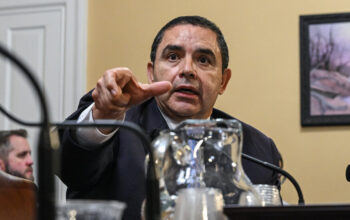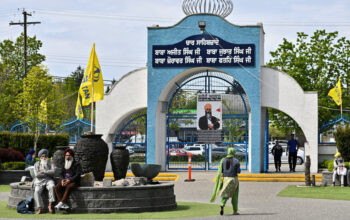
A half-dozen narco-traffickers have taken the stand at the corruption trial of Genaro García Luna over the past four weeks and said different versions of the same thing: while serving as the architect of Mexico’s bloody war on drugs, Mr. García Luna was secretly on the payroll of the country’s biggest crime group.
On Wednesday, the case went to the jury and now one question is likely to decide Mr. García Luna’s fate: Will the jurors believe the parade of criminals who testified against him?
The trial of Mr. García Luna, in Federal District Court in Brooklyn, has been unusual for several reasons. The defendant was once a cabinet-level official in Mexico but was tried in New York, accused of abusing his authority to help the Sinaloa drug cartel move tons of drugs into the city and other places across the United States.
He is the highest-ranking Mexican official ever to be tried in the United States on drug-related corruption charges, a line of prosecution that has traditionally been given less priority than the crimes of cartel kingpins.
From the start, the case revolved almost entirely around the testimony of cartel operatives who are serving sentences for their own drug crimes. And in the absence of other corroborating evidence, the jury will have to determine if the witnesses are telling the truth about Mr. García Luna, as the government has argued, or are seeking vengeance by lying about him, as the defense lawyers have claimed.
These two opposing views came to a head on Wednesday with closing arguments.
Saritha Komatireddy, a prosecutor on the case, told jurors that several of the prosecution’s witnesses had testified to bribing Mr. García Luna in various ways — “in duffel bags and briefcases and boxes full of cash” — and that their accounts were evidence that was no less real or compelling than photos or recordings.
Ms. Komatireddy also said the cooperators were perfectly placed to understand the sordid world of the cartel.
“I’m not asking you like them,” she said. “These people have done horrible things. They’re criminals. But it takes one to know one.”
Cesar de Castro, Mr. García Luna’s lead lawyer, accused the government during his own closing statement of having mounted a case with a “shocking” lack of evidence.
Mr. de Castro attacked the cartel witnesses as “killers, kidnappers, torturers, and fraudsters.”
“They’re asking you to convict a man solely on the words of some of the most notorious and ruthless criminals in the history of the world,” he said.
Even during the jury selection process, the prosecutors in the García Luna case made clear that they were not going to introduce reams of intercepted text messages or hours of recorded conversations of the sort that were used against top cartel defendants like Joaquín Guzmán Loera, the drug lord known as El Chapo, who was convicted on all charges in the same Brooklyn courthouse in 2019.
The García Luna case, as they explained, was “a cooperator case” and would rely on stories about the defendant told in person from the witness stand.
The government’s case began last month with one of those cooperators, Sergio Villarreal Barragán, a hulking former police officer known as El Grande who switched sides in the drug war and went to work for Arturo Beltrán Leyva, a powerful trafficker allied with the Sinaloa cartel.
Mr. Villarreal Barragán told the jury that in the early 2000s, Mr. García Luna — then in charge of Mexico’s equivalent of the F.B.I. — showed up at a warehouse with Mr. Beltrán Leyva to receive his cut of a drug deal: more than $14 million in cash.
Prosecutors closed their case on Tuesday after testimony from another witness from inside the cartel: Jesus Zambada García, the brother of Mr. Guzmán’s longtime business partner, Ismael Zambada García.
Echoing what he said during Mr. Guzmán’s trial, Mr. Zambada told the jury that he personally packed millions of dollars into two sports bags that were given to Mr. García Luna in the Champs Elysées restaurant in Mexico City shortly after he became the country’s public security secretary.
Between these book ends, the government called other witnesses who testified to Mr. García Luna’s corrupt alliance with Sinaloa. There was Oscar Nava Valencia, the former leader of the Milenio cartel, who claimed to have personally given the defendant $3 million during a meeting at a carwash.
Then there was Edgar Veytia, a former Mexican state attorney general, who claimed that one of Mr. Guzmán’s men had told him that the cartel once paid Mr. García Luna a $5 million bribe.
The witnesses corroborated one another not only on the subject of corruption, but also on smaller matters that could help persuade the jury that they were being truthful. Several testified about how Mr. Beltrán Leyva once abducted Mr. García Luna on a road outside Cuernavaca in a brazen display of power.
In a similar, though less weighty, fashion, a white Persian cat mentioned by one witness showed up briefly in the testimony of another.
Mr. García Luna chose not to testify in own defense and on Tuesday, his lawyers called a single witness on his behalf: his wife, Linda Cristina Pereyra Galwez. Ms. Pereyra led the jury methodically through the ways in which she and her husband purchased all of their properties and vehicles with loans or savings in an effort to suggest that the assets were not obtained with ill-gotten gains.
The charges against Mr. García Luna took years to reach the courtroom. Shortly after he left public service in 2012, federal investigators in Houston began to examine his ties to the cartel using information from witnesses like Mr. Villarreal Barragán, who was extradited that same year from Mexico to Texas.
But the investigation was ultimately closed without charges being filed because prosecutors did not believe they could win a conviction beyond the legal threshold of a reasonable doubt.
Prosecutors in Brooklyn opened another inquiry in late 2018 after Mr. Zambada’s star turn on the stand during the Guzmán trial, and unsealed an indictment against Mr. García Luna the following year after he was arrested outside Dallas.
They envisioned the case as the first in a series of U.S. prosecutions of Mexican officials suspected of corruption and in late 2020 released an indictment against Salvador Cienfuegos, the former Mexican defense secretary, on similar charges of drug-related graft.
But after intense pressure from Mexico, the Cienfuegos case was dismissed and Mr. Cienfuegos was sent back to his homeland. The collapse of that case effectively ended the desire of U.S. prosecutors to bring more corruption cases against Mexican officials.



